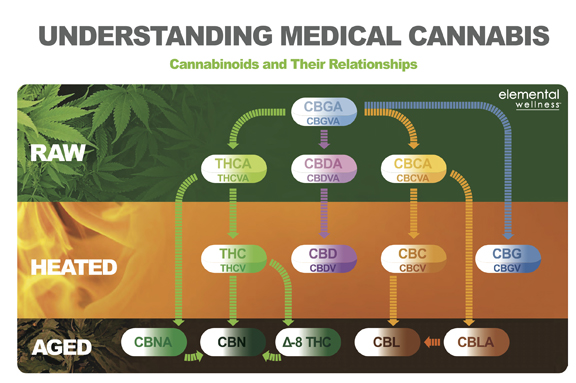CBGa, (cannabigerolic acid), is the mother of all cannabinoids. It is produced in the cannabis plant as it grows, and as the plant matures it converts itself into THCa, CBDa, CBCa and perhaps even more cannabinoids that have not yet revealed themselves to science. These secondary cannabinoids in turn will convert themselves slowly into the more commonly know THC, CBD, CBC and also CBG as the plant naturally matures and decarboxylates, and are fully converted when high heat is applied, as in smoking, vaping or cooking. (When the carbon molecules are transformed by plant maturity, UV light, heat, and high temperature heat the process is called decarboxylation.)
How much of the CBGa that will convert to each of the other cannabinoids and in what ratio depends mostly on genetics and to some extent, growing conditions. Industrial hemp plants tend to have more conversion to CBG and CBD than plants that have been bred for a high THC content, but so much cross breeding over the last several decade has made many exceptions to any straight forward rules.
But how important is CBGa or CBG to our health? A lot less is known about CBGa, the precursor to cannabinoids, than is known about the cannabinoids themselves, because there just hasn’t been that much study on it, but we do know a little and what we know is promising. We know that neither CBGa or CBG will get you high, and according to studies by Steep Hill Labs, (formerly Steep Hill/Halent), CBG binds more to the CB1 receptors in our bodies, (located mostly but not exclusively in the central nervous system), than to CB2 receptors, (located in other peripheral locations and internally such as the digestive tract), and is considered to be classified as an antagonist. And we know they have healing properties.
 To learn more about what cannabis agonists and antagonists are please read this older post: How Cannabinoid Receptors Work like Football. Drugs are commonly antagonist or agonist with regards to how our body receives and utilizes them. Because cannabis medicine provides us with both agonists AND antagonist constituents, this may be why it is so versatile with regards to our health and well being. CBG, (cannabigerol) is an antagonist that will mostly bind to the CB1 receptors in our bodies. Our body’s own endocannabinoid system will use CBG to regulate itself and other systems that are in need, sometimes before that need has even become apparent to us.
To learn more about what cannabis agonists and antagonists are please read this older post: How Cannabinoid Receptors Work like Football. Drugs are commonly antagonist or agonist with regards to how our body receives and utilizes them. Because cannabis medicine provides us with both agonists AND antagonist constituents, this may be why it is so versatile with regards to our health and well being. CBG, (cannabigerol) is an antagonist that will mostly bind to the CB1 receptors in our bodies. Our body’s own endocannabinoid system will use CBG to regulate itself and other systems that are in need, sometimes before that need has even become apparent to us.
 CBGa is an analgesic and anti-inflammatory.
CBGa is an analgesic and anti-inflammatory.
CBG is an analgesic, anti-inflammatory, anti-bacterial, anti-cancer, anti-fungal, antidepressant, and stimulates bone growth.
That’s good news. I have included some charts here that were created by Elemental Wellness, promoted by Steep Hill Labs, and are meant to be shared for educational purposes. They show the progress of how cannabigerol transforms into other cannabinoids and the synergistic terpenes associated with cannabigerol. I also offer this link to a great little pdf booklet by Elemental Wellness: (Understanding Cannabis), a handy reference to cannabinoids, terpenes and the therapeutic effects of medical cannabis. It is chock full of wonderful references to all sorts of facts on cannabis as medicine. Enjoy, and never stop learning!

This. Is. AWESOME!!! I will be back again and again and again to read your blog. You are a blessing to this world!